
Directed by Mick Jackson
Visual Effects Supervisor: Mat Beck
VOLCANO Miniature Director of Photography: David Drzewiecki
Physical Effects Supervisor: Clay Pinney

Directed by Mick Jackson
Visual Effects Supervisor: Mat Beck
VOLCANO Miniature Director of Photography: David Drzewiecki
Physical Effects Supervisor: Clay Pinney
LIGHT MATTERS, INC.
POP FILM, Supervisor: Stuart Robertson
DIGISCOPE
STIRBER VISUAL NETWORK (Action Miniatures)
DIGITAL MAGIC
Nominated for two 1997 VFX HQ Awards: Best Models/Miniatures and Best Miniature Pyrotechnics.
Be sure to read the Spotlight article, VFX Supervisor Mat
Beck Goes With the Flow on VOLCANO
L.A.'s in trouble. But this time, it's not due to earthquakes, brush fires, mudslides
or riots. The residents of Southern California struggle to fight an unexpected
volcano that erupts right under their proud city.
Tommy Lee Jones stars in the second volcano flick of the year, aptly titled VOLCANO.
The film is a fiery, fast-paced disaster flick in the truest sense. The visual
effects for the film (around 250 shots) are top notch and dazzling, and were accomplished by a great
group of effects companies and digital artists.
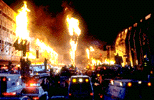 Visual Effects Produced by:
Visual Effects Produced by:
VIFX, Supervisor: John C. Wash
To look at dozens of POP Film and VIFX composites, go to POP Film's web site
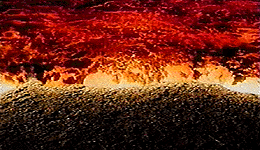
The star of VOLCANO... the lava. Many closeup shots of the slowly approaching
|
The lion's share of 3D lava and magma explosions were handled by Light Matters, Inc., while many composites of miniature lava against live-action background plates were handled by VIFX. Numerous shots were provided by Pacific Ocean Post and Digiscope, as well. A VOLCANO miniature unit handled the shooting of 1/8 scale lava elements, while the Stirber Visual Network provided building miniatures.
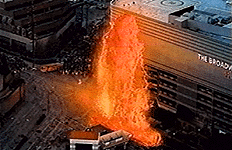
On-set pyrotechnics have been enhanced with computer
A huge "lava bomb" explodes from the volcano and nails a
|
The lava flow appears in dozens of shots--for many shots, the VOLCANO miniature crew shot a lava flow on a 1/8 scale set, and the element was digitally composited into live-action background plates. The lava, actually a harmless concoction of goopy substances, interacts quite well with the live-action plate--the edges of the lava realistically interact with cars, buildings, palm trees, whatever.
The film contains many, many wide shots that are simply spectacular, and do not appear as if they are visual effects. The lava and heat distortion fit perfectly into the shot. Intense rotoscoping was necessary for many shots where people walk in front of the lavaflow.
Especially memorable shots include the incredible sequence near the end of the film, where city emergency crews blow up a building in an attempt to re-route the lava's path. In a series of dramatic overhead shots, the building collapses dangerously close to our heroes, running frantically from their immenent destruction. These overhead shots are extremely detailed and very realistic. They depict events that actually appear to be occuring right in front of our eyes.

In this dazzling overhead shot, the rescue crews successfully cause an enormous building to topple to the ground. The ash covered building comes to the ground quite realistically.
|
The final shot of the film is a stunning, wide helicopter shot of Los Angeles, and includes the newly formed Mt. Wilshire. Smoke and ash cover the sky, while remants of the lava flow are visible. The shot lingers for a LONG time, and defects and digital signatures are undetectable.
There are only a few moments in the film where the visual effect is obvious. In a few geyser and fire shots, portions of the shot run at 24 frames per second (normal film), while elements within the frame run at a slower frame rate. It happens a few times in the film, and it is quite unfortunate, since it draws the viewer out of the picture and makes them conscious of the effect.
This slight criticism aside, the visual effects for VOLCANO (under the supervision of Mat Beck) are intense, richly detailed, and highly photorealistic.
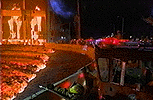
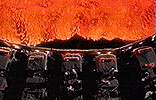
In this spectacular sequence, rescuers take a stand against
|
It's hard NOT to compare VOLCANO with this year's earlier volcano flick, DANTE'S PEAK, with visual effects provided by Digital Domain. The fact is that these two films are quite different, not only in terms of plot and characters, but in visual effects. The volcano in DANTE was quite enormous, and shots were of a grand, large scale. Entire portions of mountain get blown away, and a huge pyroclastic cloud obliterates everything in its path.
VOLCANO perhaps should have been entitled, "LAVA," since the film focuses on the dangerous lava flow. The majority of effects shots are images of the creeping lava, while DANTE'S PEAK contained a much smaller number of lava shots. Both films contained fantastic visual effects, but the two films are almost incomparable.
VOLCANO is a non-stop thriller. The film never slows down, and is the most pure disaster film in many years, since it doesn't fool around with character or story. The film is about logistics. A single question pervades throughout the entire film: how will they stop the lava? It's a fun ride, and certainly worth a trip to the movie theatre.
The team of effects artists on VOLCANO have done a terrific job destroying L.A. VOLCANO marks the beginning of the summer movie season, and if this film is any indication of what is coming in the next few months, this is going to be one hell of a fun summer for visual effects fans.
Check out the Spotlight article, VFX Supervisor Mat Beck
Goes With the Flow on VOLCANO
To look at dozens of POP Film and VIFX composites, go to POP Film's web site
Check out Cinefex 71.
Official Web Site: http://www.volcano.com
IMDb: VOLCANO

. . VFX HQ Produced by Todd Vaziri . . http://www.vfxhq.com . . e-mail: tvaziri@gmail.com . .
All text Copyright © 1998 Todd Vaziri, unless otherwise noted